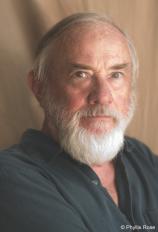Bay of Souls
Review
Bay of Souls
BAY OF SOULS is the seventh --- and shortest --- book Robert Stone
has written in a long, distinguished career that began with a
fellowship at Stanford's creative writing program where he studied
with Wallace Stegner. Since his first novel, A HALL OF MIRRORS,
Stone has alternated publication of novels and one collection of
short stories with the teaching of writing on several college
campuses across the country. In style as well as in length, BAY OF
SOULS might have been Stone's most accessible book to the
mainstream of readers. Having already received pre-publication,
starred reviews from Publishers Weekly, Kirkus and
Library Journal, this book is unlikely to suffer much from
one review that bestows criticism along with the accolades.
All of Robert Stone's books, in one way or another, attempt to
answer life's big question: Does an individual's life have meaning?
More specifically, does the life of a white American male have
meaning? Only the setting and the age of the protagonist changes
--- and, I would argue, the way that it has changed here lessens
the significance of the book, when compared to the author's
previous work.
In BAY OF SOULS the protagonist is Michael Ahearn, an English
professor at a Midwestern University (unspecified, except for its
being in a northern plains state, in "flyover country"). Michael is
a native of the area in which he teaches. He is a nice guy and
handsome enough that, in his youth, people fell silent for a beat
when he came into a room at a party, yet self-deprecating enough to
think of himself as an overeducated farm boy. He's married to
Kristin, a tall, long-boned woman of Viking descent with dark hair,
icy eyes and a tough temperament; she also teaches. They are the
parents of Paul, an intelligent twelve-year-old who attends a
Catholic school because they want him to have an opportunity to
grow up with the religious faith they both --- she a Lutheran, he a
Catholic --- retain only tenuously. All is well enough with the
small family until two things happen: Paul gets lost in the snow
and almost dies, while Michael meets a woman who is as out of place
as an orchid in snow.
The woman's name is Marie-Claire Purcell, called Lara for some
reason that goes unexplained. She too is a professor, of political
science, but she's a newcomer on the campus and her background is
so atypical that Michael investigates via the Internet; he
concludes that she is a spy in hiding. She's been stashed in
relative isolation by the government, presumably the CIA, for her
own protection. Lara has American citizenship because her mother
was an American and she, Lara, was born in New Orleans. But her
home is on the island of St. Trinity in the Caribbean and her roots
are deep in that culture, despite the apparent whiteness of her
skin.
The book begins with an archetypal hunting scene. In fact, every
character and each major event in BAY OF SOULS is an archetype.
Michael is the genial, hapless fool in the Tarot deck, a role
heavily foreshadowed in the opening hunting scene. Kristin is the
Ice Princess. Lara is the Whore of Babylon --- and Michael knows
it, calling her the Great Whore in his mind. This does not deter
him from having an affair with her.
Lara believes she has no soul, that her soul was taken from her
years ago by her twin brother and now kept with his own soul in the
ocean after he died of AIDS a year ago. Lara's religion is voudun,
or voodoo. The people of St. Trinity believe the souls of their
dead are kept for one year at the bottom of their island's bay, in
a kind of purgatory. At the end of a year, they must perform a
ritual to bring the dead soul up out of the bay and allow them to
continue on, either to heaven or hell. Lara returns to St. Trinity
for the ritual, believing that at this time she can reclaim her own
soul. She takes Michael with her. He leaves his home and family in
order to go. Ostensibly, this is a week's vacation for the purpose
of diving in the Caribbean --- but in reality it's an archetypal
journey, a descent into the unknown, of the sort that used to be
marked on maps with a notation "here be monsters."
Lara's character is more complex than Michael allows or wants her
to be. He desires her for her sexuality and her physical vitality.
But she believes she is genuinely in love with him and that he may
be a part of her redemption --- he becomes essential to her effort
to get back her soul.
The sheer craftsmanship of Robert Stone's writing style in BAY OF
SOULS cannot be faulted; to say that it is perhaps self-consciously
Faulknerian or Hemingway-esque would be quibbling when he has
accomplished this to such perfection. Nor can his intent to tackle
the big questions of identity, faith and redemption. One might even
argue that he has shown courage in presenting a protagonist whose
profession and proclivities are so close to his own. Yet there is
little that is original in BAY OF SOULS --- the material is
solipsistic and self-referential and this trivializes a tale meant
to be universal in scope. Stone uses the archetypes to reach for
greatness, but in my opinion he falls short.
Reviewed by Ava Dianne Day on January 21, 2011










